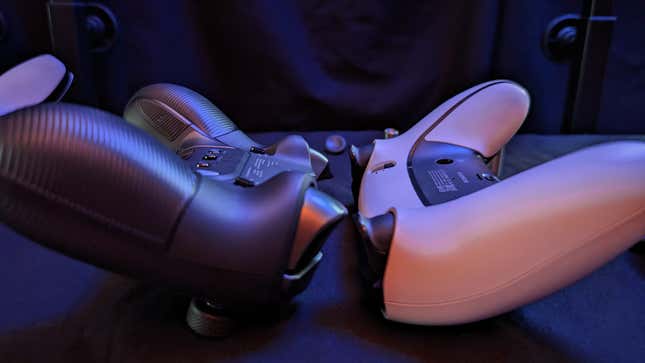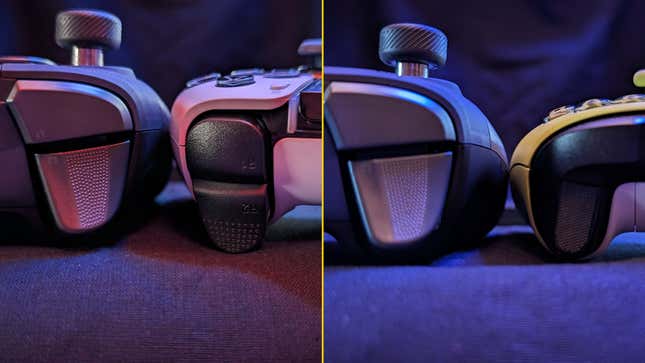The design of the video game controller as we’ve known it has largely remained the same for the last 20 years: a d-pad, two analog sticks, four face buttons, and four shoulder buttons. It persists from the first PlayStation’s DualShock, all the way through to the modern PS5’s DualSense, as well as various Xbox and Nintendo controllers.
Recent years have seen a rise of “Elite” and “Pro” controllers that pledge to offer added performance, most often in competitive games where keeping your thumbs on the analog sticks as often as possible affords you an edge over your opponents. The Nacon Revolution 5 Pro controller for PS5, PS4, and PC is a relatively new challenger in this market, and it promises four rear-positioned buttons and, perhaps most alluringly, thumbsticks that will never drift.
As a hybrid PlayStation and PC gamepad, the Revolution 5 Pro is flanked by offerings from both Sony and Microsoft. Coming in at $200, it directly competes with Sony’s pro-level controller, the DualSense Edge (which is at the same price point). On the PC front, the Xbox Elite Controller undercuts it by about $30 bucks. Neither of the Revolution 5’s first-party opponents offer the drift-free analog sticks, however (though you can purchase third-party driftless analog sticks for the DualSense Edge which slot right in).
But while its driftless tech makes a solid argument for its inclusion in your gaming arsenal, in my experience, the Nacon Revolution 5 Pro is a bit too uncomfortable to use.
Wonderful on paper but painful in the hands
The Revolution 5 Pro boasts a ton of impressive specs: four permanently placed rear buttons assignable on-device with a quick button combo and four different profiles; two swappable d-pads (a traditional T-shaped one and a “satellite dish” variant common on Xbox controllers); three pairs of weights you can slot into the controller to change its heft; swappable joystick rings of two different thicknesses, and six changeable joystick heads; wireless support for both PC and PlayStation (you need to sacrifice a USB port if you want to use it wirelessly on PlayStation), and two degrees of adjustable trigger throw range for both minimal and full depth as well as full gyro support for PlayStation.

What causes drift?
A modern gremlin of gaming tech, controller drift is the result of wear and tear or debris building up inside your average analog stick’s potentiometer tech. Almost all controllers that use potentiometers will succumb to this sooner or later. Like the Sega Saturn and Dreamcast controllers before it, the Revolution 5 Pro features “hall effect” analog sticks, which use magnets for contactless signal communication. The result? There are no physical parts inside rubbing up against each other, thus these thumbsticks won’t succumb to the same wear and tear as potentiometers do.
The Revolution 5 features an asymmetrical thumbstick layout which might rub you the wrong way if you’re a PlayStation purist—I prefer symmetrical layouts, but I was excited to try this out. Unfortunately, despite its wonderful list of features, this controller and I just never got along.
The Revolution 5’s ergonomic problems lie in two places: the shoulder buttons and the curve under L2/R2 where your middle or ring finger will rest. On that second point, the controller seems to either want to sit forward in my hands, or tilt backwards, so I often fidget with it while playing. This, I suspect, is what gave me a perceived decrease in gameplay performance in shooters like Halo Infinite on PC—I was too distracted trying to get the controller to sit well in my hands. Most concerningly, long sessions would numb or cramp my hands in ways that other, more ergonomic controllers, simply don’t.

For the record, I am a passionate lover of the traditional Xbox “Duke” controller and often play wide-necked, baritone-scale 8-string guitars when I’m not gaming. So hand size and large objects are not a problem for me.
And the shoulder button shape and positioning makes the Revolution 5 feel like it isn’t sure if it wants to be a PlayStation or Xbox controller. When the Xbox 360 arrived in 2005, it repositioned the OG Xbox’s “black and white” buttons to the shoulders. But it did so as “bumpers,” differentiating it from the PlayStation controller in a way that encourages you to use the sides of your index fingers to actuate them. This has the benefit of letting you keep your index or “trigger” fingers on the…well, triggers. That makes it a great design for shooters.

Xbox controllers, especially modern ones, have a gentle concave notch in the bumpers that accommodates the upper shape of the tip of your index finger, or the “distal phalanx.” PlayStation controllers, however, have more conventionally required a forked, two-finger grip from gamers, though modern DualShock 4 and DualSense controllers have just enough of a curved shape on the L1/R1 that you can get away with a grip similar to what you’d use on an Xbox.
The Revolution 5, however, doesn’t feature the concave curve of the Xbox’s bumpers nor the gentle slope inwards of the DualSense. The L1/R1 buttons end with a rigid 90-degree angle that just doesn’t accommodate a standard Xbox grip. But as it’s shaped more like an Xbox controller in the shoulder area, it doesn’t feel comfortable to do PlayStation’s two-finger forked grip either.
This difference meant that during gameplay I kept swapping up my grip. This, I suspect, was another reason my performance in Halo got worse: I was too distracted by trying to find a way to comfortably and reliably hold this otherwise pretty feature-rich controller.
At the end of the day, however, the onboard hall effect thumbsticks are not to be underestimated. Nowadays it seems like controller drift becomes worse with every new generation, so plunking down a chunk of cash for a controller that will outlast a purchase of two or three of them is definitely tempting
A solution for aging consoles?
That the Revolution 5 uses driftless hall effect technology does make me consider its utility as a way to extend the longevity of a PS4, which over time will see its DualShock 4s harder to secure. The same can be said for the PS5 as it grows older. Yes, there are other ways that controllers can develop problems and fail (my delightfully chartreuse Xbox wireless controller has lately seen the d-pad randomly press itself), but drift remains one of the most insidious and difficult-to-fix problems.
Despite the issues I had with comfort (or lack thereof), I do think there’s value in the Revolution 5 Pro as a long-term, purchase—though at $200, that’s still kinda steep. Sure you can replace the thumbsticks on the identically priced DualSense Edge, thus prolonging its life, but that adds to its cost.
The Revolution 5 Pro impresses on paper and has a premium feel to it—one that’s sadly distorted by some uncomfortable design choices. There’s good reason to consider grabbing one for its added customization, four rear buttons, and awesome thumbsticks, but you may want to hold one before buying to see if it’s a good fit—literally.







the1.21updateofficialnameis..._minecraftmonthly-youtube-googlechrome4_26_20242_39_36pm-300x300.png)















